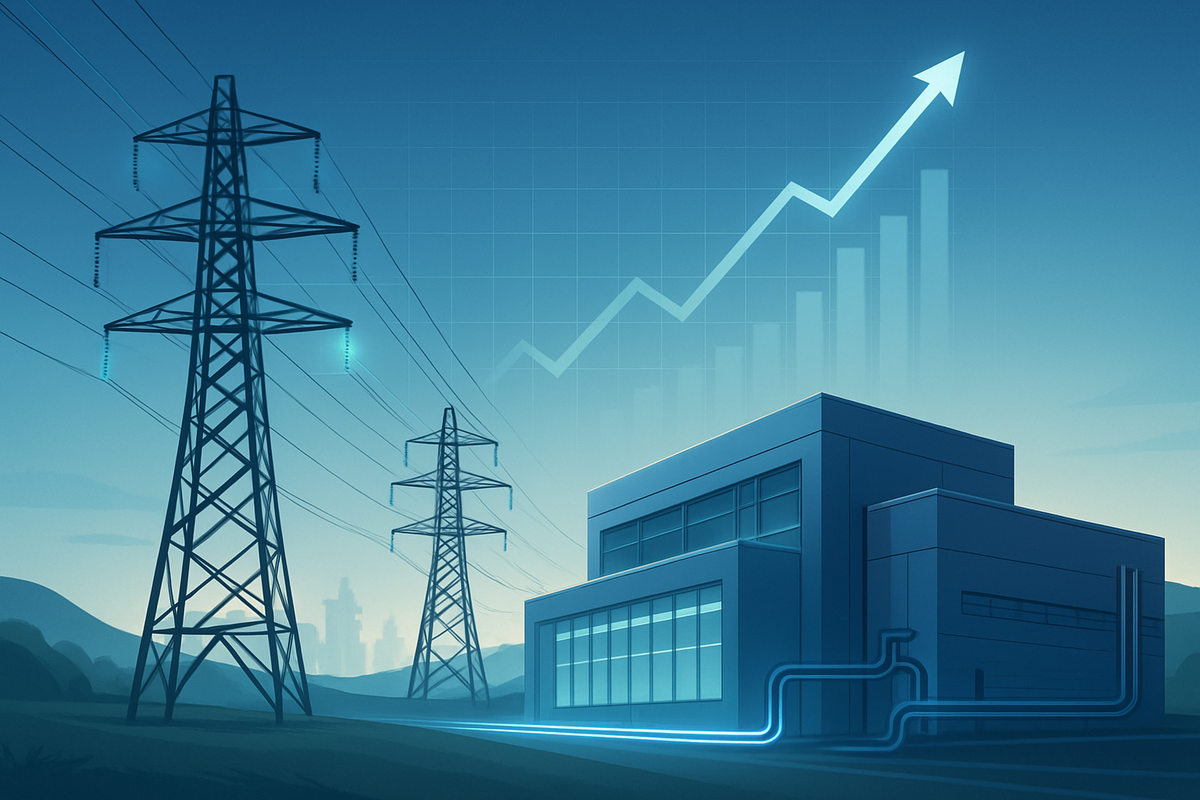
Quanta Services (NYSE: PWR) is experiencing a significant stock breakout, with its shares reaching new highs as of October 8, 2025. This remarkable surge is directly attributable to the escalating global demand for Artificial Intelligence (AI) infrastructure, positioning Quanta Services as a critical enabler in the AI revolution. The company's strategic focus on modernizing the electric grid and expanding data center capabilities has resonated strongly with investors, signaling a "golden age" for infrastructure providers essential to powering the future of AI.
The immediate implications of this breakout are profound, highlighting the increasing valuation of companies at the forefront of building the physical backbone for digital transformation. Quanta Services' robust performance underscores a broader market recognition that the software and algorithms of AI are only as powerful as the underlying hardware and energy infrastructure supporting them. This shift in investor focus towards the foundational elements of technology marks a pivotal moment for the utility and specialized contracting sectors.
The Foundation of AI: Quanta Services' Strategic Ascent
Quanta Services' recent stock performance has been nothing short of spectacular, driven by a confluence of strong financial results and strategic positioning within the burgeoning AI infrastructure market. As of October 8, 2025, the company's stock hit a new 52-week high of $434.39, closing at $422.45, part of a sustained upward trajectory that saw a 7-day streak of gains leading up to October 6, 2025. Year-to-date, Quanta Services has delivered an impressive 35.5% return, significantly outpacing the broader S&P 500's 14.6%.
This momentum is supported by overwhelmingly positive analyst sentiment. Truist Securities, on October 8, 2025, reiterated a "Buy" rating and raised its price target for PWR from $472 to $521, a testament to the company's robust outlook. This follows similar upgrades from Jefferies and Evercore ISI Group in recent months. The consensus "Outperform" rating from 32 brokerage firms, with an average target price of $418.65, reflects widespread confidence in Quanta's trajectory. Financially, Quanta Services has consistently exceeded expectations, reporting Q2 2025 revenue of $6.77 billion, surpassing analyst estimates and marking a 21.1% year-over-year increase. The company also raised its full-year guidance, projecting revenues between $27.4–$27.9 billion.
The timeline leading to this moment has been characterized by Quanta Services' proactive investments and strategic acquisitions. The company has steadily built out its capabilities in electric utility, communications, and energy infrastructure, all of which are crucial for AI development. Key players involved include major technology companies investing heavily in AI data centers, as well as utility providers seeking to modernize their grids to accommodate the massive power demands. Quanta's "self-perform" model, which involves managing the entire project lifecycle in-house, has provided a competitive edge by minimizing risks and ensuring consistent execution.
Initial market reactions have been overwhelmingly positive, with the stock breakout signaling a re-evaluation of infrastructure companies' role in the tech ecosystem. While some analyses suggest the stock might be "a little pricey" with a forward P/E of 33.4, the long-term growth prospects driven by AI demand appear to outweigh immediate valuation concerns for many investors. The market is clearly betting on Quanta Services' ability to continue delivering essential services for the foundational build-out of the AI era.
Winners and Losers in the AI Infrastructure Race
The accelerating demand for AI infrastructure, epitomized by Quanta Services' (NYSE: PWR) breakout, is creating a clear delineation of winners and losers within the broader market. Companies positioned to benefit significantly are those involved in the entire lifecycle of data center construction, power generation, and grid modernization. Conversely, firms heavily reliant on older infrastructure models or those unable to adapt to the rapid technological shifts may face headwinds.
Companies Poised to Win:
- Quanta Services (NYSE: PWR): As highlighted, Quanta is a primary beneficiary. Its comprehensive services, from electric power and renewable energy to underground utilities and specialized data center construction, make it indispensable for AI development. Strategic acquisitions like Dynamic Systems, a leader in mechanical and process infrastructure, and Cupertino Electric, further solidify its direct connection to AI data center demand.
- Other Infrastructure & Engineering Firms: Companies like Dycom Industries (NYSE: DY), although a past acquisition target of Quanta, and other major engineering and construction firms with strong utility and communications divisions, stand to gain. These include MasTec (NYSE: MTZ), which also operates in the infrastructure construction space, and AECOM (NYSE: ACM), a global infrastructure consulting firm. Their ability to deliver large-scale, complex projects for data centers and grid upgrades will be crucial.
- Power Generation & Transmission Companies: The "insatiable appetite" of AI for data centers necessitates massive increases in power generation and transmission capacity. Utilities and power companies involved in building new power plants (especially renewable energy sources) and upgrading transmission lines will see increased demand for their services and infrastructure.
- Fiber Optic & Connectivity Providers: Modern data centers require extensive, high-speed fiber-optic networks. Companies specializing in fiber deployment and connectivity solutions, such as Corning (NYSE: GLW) and various telecom infrastructure providers, will be critical enablers.
Companies That Might Face Challenges or Need to Adapt:
- Legacy Data Center Providers (without modernization): Data centers that are not equipped to handle the extreme power density, cooling requirements, and network demands of AI workloads may become obsolete or require significant capital expenditure to upgrade.
- Traditional Energy Companies (without renewable integration): While AI demands more power, there's also a strong push for sustainable and renewable energy. Energy companies that fail to invest in and integrate renewable sources into their portfolios may miss out on significant contracts for powering green AI data centers.
- Companies with Limited Specialization: The complexity of AI infrastructure requires highly specialized engineering and construction expertise. Generalist construction firms without specific capabilities in high-performance computing (HPC) environments, advanced cooling systems, or complex electrical installations may find it difficult to compete.
The overall impact on these companies will depend on their strategic agility and investment in capabilities aligned with the AI-driven infrastructure boom. Quanta Services' success serves as a blueprint for how to capitalize on this transformative trend.
The Broader Implications of the AI Infrastructure Boom
Quanta Services' (NYSE: PWR) stock breakout is more than just a company-specific success story; it's a powerful indicator of broader industry trends and the escalating demands of the Artificial Intelligence era. This event fits squarely into the overarching narrative of a global infrastructure renaissance, driven by digitalization, decarbonization, and decentralization. The "golden age" of infrastructure, as many analysts term it, is not merely about maintenance but about a fundamental reimagining and expansion of foundational systems to support unprecedented technological advancement.
The ripple effects of this trend are significant. Competitors in the utility and specialized contracting space, such as MasTec (NYSE: MTZ) and MYR Group (NASDAQ: MYRG), are likely to see increased investor scrutiny and pressure to demonstrate their own capabilities in AI infrastructure. Those with strong data center or grid modernization portfolios may also experience upward valuation adjustments, while those lagging could face investor skepticism. Partners, including equipment manufacturers, raw material suppliers, and technology integrators, will witness a surge in demand for their products and services, creating a robust ecosystem around AI infrastructure development. This could lead to increased M&A activity as companies seek to acquire specialized capabilities or consolidate market share.
Regulatory and policy implications are also substantial. The immense power demands of AI data centers will put significant strain on existing electrical grids, necessitating expedited permitting processes for new power generation and transmission projects. Governments may introduce incentives for sustainable data center development, including tax breaks for using renewable energy sources or for investing in energy-efficient cooling technologies. Furthermore, national security concerns related to critical infrastructure will likely lead to increased regulatory oversight, particularly for data centers handling sensitive AI workloads. Policy discussions around energy consumption, carbon footprints, and grid resilience will intensify, shaping the operational landscape for companies like Quanta Services.
Historically, this situation draws parallels to the dot-com boom of the late 1990s, where the underlying network infrastructure providers became critical enablers, and the subsequent build-out of mobile network infrastructure in the 2000s. In both instances, the companies laying the physical groundwork experienced significant growth and investor interest. However, the current AI infrastructure boom is arguably more complex, involving not just data transmission but also massive power generation, cooling, and advanced mechanical systems, making the scope of work for companies like Quanta Services even more expansive and critical. The sheer scale and speed of AI development mean that the demand for robust, reliable, and sustainable infrastructure is unprecedented.
What Comes Next: Navigating the Future of AI Infrastructure
The trajectory set by Quanta Services' (NYSE: PWR) stock breakout suggests a dynamic and rapidly evolving landscape for AI infrastructure in the coming years. In the short-term, we can expect continued robust demand for Quanta's services as hyperscalers and enterprises race to build out their AI capabilities. This will likely translate into strong order backlogs and sustained revenue growth for the company. Other infrastructure providers with specialized expertise in power, data centers, and fiber optics will also likely see increased opportunities.
Long-term possibilities include the further integration of renewable energy solutions into data center design, driven by both corporate sustainability goals and regulatory pressures. The development of advanced cooling technologies and more efficient power distribution systems will become paramount to manage the immense heat and energy consumption of AI hardware. We might also see a geographical expansion of data center construction beyond traditional hubs, as companies seek to optimize for energy costs, land availability, and proximity to renewable energy sources. This could create new market opportunities for regional infrastructure providers.
Potential strategic pivots or adaptations required by companies in this space will include a continuous focus on innovation in construction techniques and materials to improve efficiency and reduce environmental impact. Investing in workforce development to train skilled technicians and engineers for specialized AI infrastructure projects will be crucial, given potential labor shortages. Furthermore, fostering deeper partnerships with AI hardware manufacturers and software developers could lead to more integrated, optimized infrastructure solutions.
Market opportunities will emerge in areas such as modular data center construction, edge computing infrastructure tailored for AI applications, and specialized services for retrofitting existing data centers to meet AI demands. Challenges will include managing supply chain complexities for critical components, navigating evolving regulatory environments, and mitigating the environmental impact of massive energy consumption. Potential scenarios range from a sustained, steady growth fueled by AI adoption to periods of accelerated build-out followed by consolidation, depending on the pace of AI innovation and economic cycles. The underlying theme, however, is a persistent and growing need for the foundational infrastructure that Quanta Services provides.
A New Horizon for Infrastructure Investment
Quanta Services' (NYSE: PWR) recent stock breakout serves as a powerful testament to the critical, and increasingly recognized, role of infrastructure in the age of Artificial Intelligence. The event underscores a fundamental shift in market perception, where the physical backbone enabling digital innovation is now valued as highly as the software and hardware it supports. Key takeaways include the indispensable nature of robust power grids, advanced data centers, and extensive fiber-optic networks for AI's continued expansion. Quanta's strategic foresight, comprehensive service offerings, and timely acquisitions have positioned it as a dominant force in this burgeoning market.
Moving forward, the market will likely continue to reward companies that can demonstrate clear capabilities and a strong execution track record in building and maintaining AI infrastructure. Investors should assess firms not just on their current financial performance but also on their strategic alignment with future technological demands, particularly in areas like sustainable energy integration, advanced cooling solutions, and specialized data center construction. The "picks and shovels" providers of the AI gold rush are proving to be immensely valuable.
Final thoughts on the significance and lasting impact of this trend point to a sustained period of investment in infrastructure globally. The demands of AI are not fleeting; they represent a fundamental re-architecture of our digital and physical worlds. Quanta Services' success highlights that the utility and specialized contracting sectors are no longer just about maintaining legacy systems but are at the forefront of enabling the next wave of technological revolution.
What investors should watch for in the coming months includes Quanta Services' upcoming earnings reports for continued strong guidance, further strategic acquisitions that enhance its AI infrastructure capabilities, and any new partnerships with major technology companies. Additionally, monitoring broader trends in data center construction spending, developments in renewable energy infrastructure, and regulatory changes related to energy consumption and environmental impact will provide crucial insights into the long-term sustainability and growth prospects of this vital sector.
This content is intended for informational purposes only and is not financial advice.





